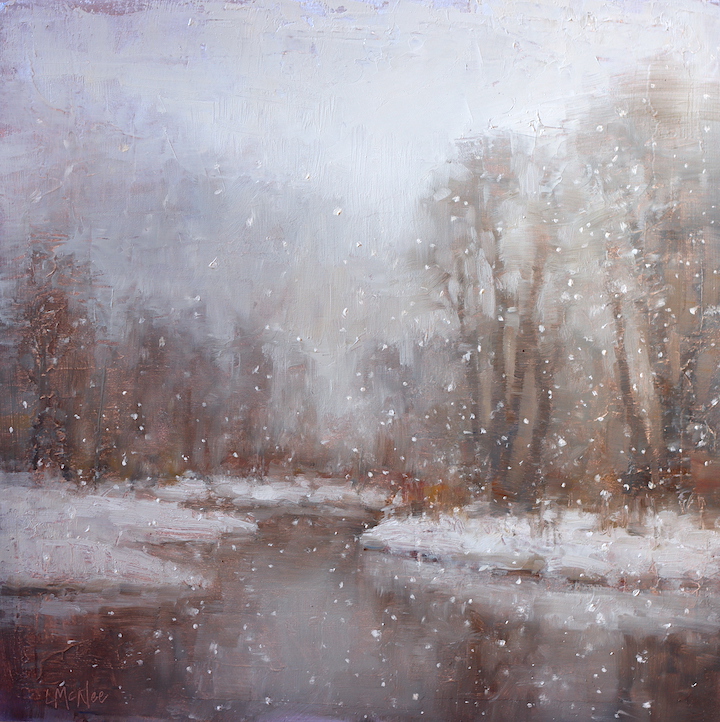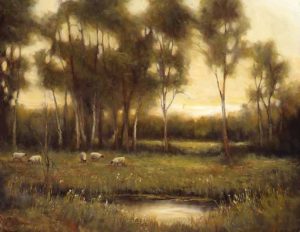
TONALISM is a painting movement that is still popular today.
Originally, it was derived from the French Barbizon movement which emphasized atmosphere and shadow and harmonized nature with man – all this was done on location directly from nature.
The tonalists did not like to be defined by any particular art movement. But, when pressed on this issue, the early tonalists most often used the term Luminism to refer to their approach toward painting.
Their view on the landscape was similar but differed from the Luminists a bit.
For example:
- Tonalists did outdoor color studies and then completed the paintings indoors.
- Tonalist painting expressed a sense of unity over diversity, tranquility over activity and spirituality over physical.
- Tonalists preferred to convey a feeling for the passage of time.
- Tonalists used more brushwork than the Luminists.
It was not until 1972 when art historian, Wanda Corn in her catalog, “The Color of Mood: American Tonalism, 1880-1910,” coined the movement as Tonalism. I am personally drawn to this style of landscape painting.

The Wikipedia definition explains:
This style of painting (about 1880 to 1915) is an artistic style that emerged in the 1880s when American artists began to paint landscape forms with an overall tone of colored atmosphere or mist. Dark, neutral hues, such as gray, brown, or blue, would usually dominate such compositions. During the late 1890s American art critics began to use the term “tonal” to describe these works. Two of the leading painters associated with this style are George Inness and James McNeill Whistler. Tonalism is also sometimes used to describe American landscapes derived from the French Barbizon style, which employs an emphasis on mood and shadow. Tonalism, in both its forms, was eclipsed by the popularity of Impressionism and European modernism.

Characteristics of Tonalism:
- poetic
- an elegant landscape (sometimes with a lone figure)
- a contemplative person
- sparsely decorated
- tonally uniform
- luscious and luminous
- atmospheric effects
- simplified subject matter
- misty, vaporous
- evocative moonlit night
- quiet and minimal
- warm hues of brown, green, gauzy yellow, and muted grays
- evoke a sense of emotionalism over reality
- subjective interpretation of nature.
(Summer Light by Lori McNee)
Tonalist painting began on the east coast, but in the late 1890’s it moved out west to Northern California. California boasted a strong arts community and academy of art with high standards and connections to Europe and other American art centers. These tonal paintings were a perfect aesthetic fit with the Arts and Crafts movement and the Craftsman-style bungalows of the period.
Today tonalist paintings continue in popularity for their muted colors and soft contours that evoke a quiet contemplative mood that is easy on the eye and soul.
Check out these related articles:
The Importance of Value & Tone in Painting
What is Luminism in Painting?









Thank you for a well researched and informative article.
Jeremy, I appreciate you taking time to read and comment on the Tonalism article. It was a really interesting project for me to research. I am glad you found it useful.
Best – Lori
Another very interesting and insightful blog Lori. I always look forward to reading them!!!
Hello William,
Thanks for stopping by. I find all of these topics so interesting, I am happy you enjoy them too.
Lori 🙂
I had made a search for tonalist/ism technique etc. and the pic of your painting “Summer Light” was in the top 10 I believe. I did enjoy reading your article and am much inspired to look into/study tone myself as it has been stressed by the artist Harold Speed in his reprinted book on oil painting tech and materials. I am fascinated by the beauty and softness of your painting, if one did not know better one might believe they are viewing a work from the 19th century! However, for me there is not enough of the ‘gallery glow’ to suggest that vintage. I know there is a more proper label for the yellowing of oil paintings but I refer to it as gallery gold etc. Thanks for your post and the pic it is inspiring and just a good piece of eye candy for me. I would be very satisfied to have your skilled eyes/hands and to paint in that fashion!
Well, thank you again for taking time to comment here Mark. I really am honored by your kind words about my painting. I love Harold Speed’s little old book and should dust it off sometime and re-read it myself. I hope to see you here again.
Cheers,
Lori
Lori, while this mixed media piece is derived from a 1954 35mm slide I took in France, would you label it as tonalists technique? http://bit.ly/R3dFC0
Wow Chuck! What a very cool mixed media piece. I really like it. There are tonal aspects to it, but I would consider it more surreal. What do you think? Thanks for sharing it with me.
Lori
Lori. . . Thank you so much for your posting on “Tonalisum”. I am a watercolorist, have been since the mid 70’s. I have always been interested in attemoting to represent the “color of temperature” in my work. I only recently became aware of the work of “Tonalist” Micheal Workman. What an absolut joy to view his work as well as your own, via your participation in his workshop. I am in the middle of starting to work in Oils as a painting medium, and persuing the nuance of “tonalisum” . Thank you for your resourse, direction, and insite. . .Thanks once again, Steve
Hello Steve, I am happy you discovered this post on Tonalism and found it helpful. Yes, Michael’s workshop was such a treat. Thank you for your nice words. I too am continuing the nuance of Tonalism in my own work.
Best,
Lori
i just want to know about tints and tons painting